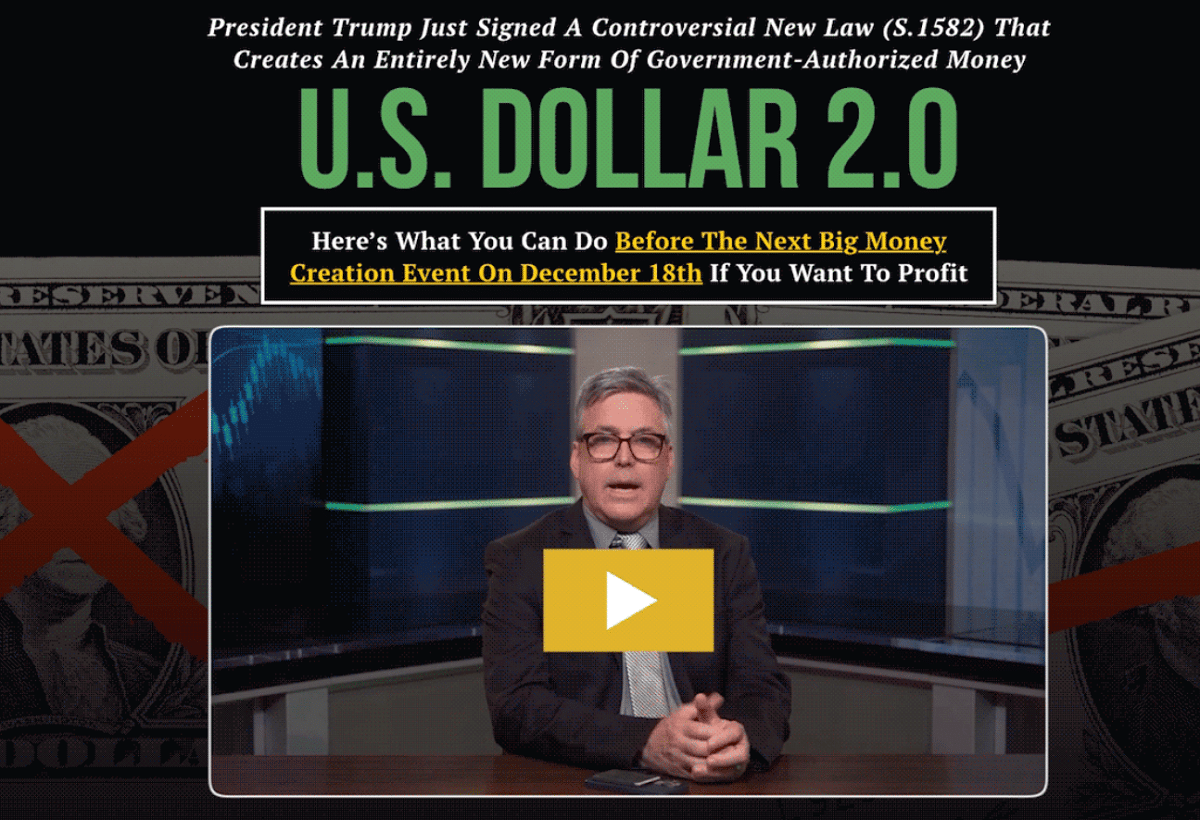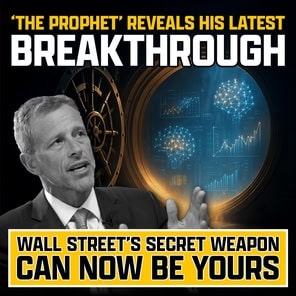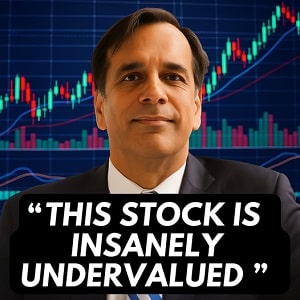In the high-stakes world of financial newsletters, few names carry the weight of Addison Wiggin. A three-time New York Times bestselling author, filmmaker behind the Oscar-shortlisted documentary I.O.U.S.A., and founding director of the Grey Swan Investment Fraternity, Wiggin has built a career warning about the perils of U.S. debt and dollar devaluation. His latest pitch? A “Dollar 2.0” revolution triggered by President Trump’s signing of S.1582—the GENIUS Act—promising up to 40X returns by 2032 through three little-known stocks at the heart of a $10 trillion shift.
But with the promo locked behind a $49–$79 quarterly subscription, investors are left wondering: Are these picks legit opportunities in the booming stablecoin market, or just another urgent sales funnel? Drawing from Wiggin’s presentation details, regulatory filings, and market data as of today, we reveal the three stocks most likely teased in his Special Report #1, evaluate their potential, and assess if joining Grey Swan is worth the intro price.
Who Is Addison Wiggin, and What’s Grey Swan Investment Fraternity?
Addison Wiggin isn’t a flashy stock-picker like Jim Cramer; he’s a macro thinker with a track record of spotting systemic cracks. Co-author of Empire of Debt (2005) and Demise of the Dollar (updated 2023 edition), Wiggin predicted the 2008 financial crisis, the housing bubble burst, and post-pandemic inflation surges. His I.O.U.S.A. film, narrated by Warren Buffett and featuring Paul Volcker, spotlighted America’s $8 trillion debt (now $36 trillion) and earned Sundance acclaim.
Launched publicly in July 2024, Grey Swan Investment Fraternity positions itself as an “inner circle” for navigating “grey swan” events—predictable crises like currency resets.
Membership ($79 for three months, renewing at $99 quarterly) includes monthly 12–18-page bulletins on commodities, AI/crypto plays, and gold hedges; weekly Zoom calls with Portfolio Director Andrew Packer; access to experts like Jim Rickards; and free e-letters like The Edge. Reviews praise its depth (e.g., “actionable macro insights”) but note the hype: “Wiggin’s doom scenarios sell fear, but his gold calls have delivered 500% since 2000.”
Wiggin’s “U.S. Dollar 2.0” pitch fits his wheelhouse: a pragmatic evolution of the fiat dollar amid de-dollarization threats from BRICS and endless deficits.
He claims S.1582 “shatters the Fed’s monopoly,” authorizing private firms to mint regulated digital dollars backed by Treasuries—potentially flooding $6.6 trillion from banks into this “new standard.” A “money-minting event” on December 18, 2025, is teased as the trigger, echoing Nixon’s 1971 gold shock.
The Dollar 2.0 Revolution: Fact or Hyperbole?
Wiggin’s thesis is grounded in reality, but amplified for urgency. Signed July 18, 2025, the GENIUS Act (S.1582) is the first federal framework for “payment stablecoins”—USD-pegged digital tokens for payments and settlements. Key rules:
- Reserves: 100% backed by USD, short-term Treasuries, or equivalents; monthly disclosures required.
- Issuance: Limited to approved banks, credit unions, or non-banks (e.g., fintechs under OCC oversight).
- No Yields: Bans interest payments to holders, pushing innovation toward efficiency, not speculation.
- AML/Sanctions: Full Bank Secrecy Act compliance, with FinCEN tailoring rules.
The Act cements USD dominance in a $300B+ stablecoin market (up 46% YoY), projected to hit $1–2T by 2030. Trump’s pro-crypto EOs (e.g., U.S. Crypto Reserve with seized Bitcoin) add tailwinds, but no “monopoly shatter”—the Fed still controls M0. The December 18 date? Unconfirmed; likely a GENIUS compliance deadline for issuers, not a profit bonanza.
Wiggin’s upside: Exporters benefit from a weaker dollar; savers earn 4–6% via Treasury-backed yields (vs. 0.5% bank rates). Risks: Regulatory delays, counterfeit tokens, or a crypto winter could stall growth.
Revealing the 3 Stocks: Our Best Bets Based on the Tease
Wiggin’s Report #1 promises “names and ticker symbols of the three little-known companies at the heart of Dollar 2.0″—firms “building, backing, and managing” the shift. You can find them in “Trump’s U.S. Digital Reserve: 3 Stocks Driving America’s Dollar 2.0 Revolution” report.
No public leaks (X searches for “Wiggin Dollar 2.0 stocks” yielded zero recent hits), but context points to stablecoin ecosystem players. We infer these as:
1. Circle Internet Group (NYSE: CRCL) – The Core Issuer Circle, issuer of USDC (second-largest stablecoin at $74B market cap), embodies Wiggin’s “powerful financial institution.” Post-GENIUS IPO on June 6, 2025, shares surged 230% to ~$45 (up 14% post-signing). Valuation: $5B. Why? GENIUS clarity enabled the public debut; USDC settles trillions annually, powering DeFi and remittances.
BlackRock manages most reserves, tying to Wiggin’s Treasury backing.
Legit Potential: High. Revenue up 78% YoY to $1.5B; partnerships with Stripe/Visa. 40X by 2032? Stretch (needs $200B market cap), but 5–10X feasible if stablecoins hit $1T.
2. Robinhood Markets (NASDAQ: HOOD) – The Global Highway Builder Robinhood co-founded the Global Dollar Network (GDN) with Kraken and Galaxy Digital, launching USDG—a Singapore-regulated stablecoin on Solana/Ethereum for cross-border settlements.
Shares: ~$28 (up 50% YTD 2025). Why? GDN’s “financial superhighway” (Wiggin’s Report #2) rewards partners with 100% reserve yields; Robinhood’s $200M Bitstamp acquisition integrates USDG for 24/7 trading.
Legit Potential: Solid. User base (25M+) drives adoption; crypto revenue now 40% of total. Analysts forecast 3X growth, but 40X requires DeFi dominance.
3. BlackRock (NYSE: BLK) – The Backdoor Reserve Giant The “most profitable company on Earth” (~$20B 2025 profits) manages USDC reserves and launched BSTBL—a Treasury-only fund for stablecoin issuers under GENIUS. Shares: ~$950 (up 15% post-GENIUS). Why? Fits the “hidden backdoor” with $5B+ in crypto assets; partners with Stripe for issuance.
Legit Potential: Blue-chip safe. AUM at $13.5T; tokenized funds like BUIDL yield 5%. 40X unlikely (mature giant), but 2–3X via crypto fees.
| Stock | Ticker | YTD Return (as of Oct 17, 2025) | Market Cap | Key Dollar 2.0 Tie | Upside Risk |
|---|---|---|---|---|---|
| Circle | CRCL | +230% | $5B | USDC issuer; GENIUS enabler | High volatility; regulatory scrutiny |
| Robinhood | HOOD | +50% | $25B | GDN co-founder; USDG infra | Competition from Coinbase |
| BlackRock | BLK | +15% | $140B | Reserve manager; BSTBL fund | Slower growth as mega-cap |
These align with Wiggin’s ecosystem: issuance (CRCL), infrastructure (HOOD), backing (BLK). Alternatives like Paxos (private, PYUSD issuer) or World Liberty Financial (Trump-backed USD1, $2.6B cap but no stock) are close but less “investable.”
Are These Picks Legit? The Verdict
Yes, with caveats. Wiggin’s stocks tap a real $10T opportunity: Stablecoins processed $27.6T in 2024 (beating Visa/Mastercard), and GENIUS could accelerate enterprise adoption (e.g., Walmart/Amazon pilots). CRCL and HOOD offer explosive growth; BLK adds stability. Past wins (Wiggin’s uranium tease via CCJ up 100% in 2025) bolster credibility.
Red Flags: 40X claims are speculative—stablecoin market could 5–10X, not 40X per stock. December 18 hype lacks confirmation; auto-renew traps subscribers. Grey Swan suits risk-tolerant macro fans (A+ BBB rating), but test the 30-day refund.
How to Play Dollar 2.0
- Direct Buys: Allocate 5–10% to CRCL/HOOD; 20% to BLK ETF (iShares: IBLK).
- Hedges: Wiggin’s staple—gold (GLD ETF) for devaluation protection.
- Free Intel: Watch Wiggin Sessions on YouTube; track Treasury.gov for GENIUS updates.
- Broader ETFs: ARK Fintech (ARKF) for stablecoin exposure.
Wiggin’s Dollar 2.0 isn’t a get-rich-quick scheme—it’s a bet on USD’s digital pivot. If stablecoins redefine money (as Visa predicts), these picks could shine. Subscribe for the reports if macro thrills you; otherwise, dip in via brokers. In Wiggin’s words: “The dollar’s curse is endless deficits—but its upgrade could mint fortunes.”
FAQ: Addison Wiggin’s “U.S. Dollar 2.0” and Grey Swan Investment Fraternity
What is Addison Wiggin’s “U.S. Dollar 2.0”?
“U.S. Dollar 2.0” refers to Wiggin’s vision of a new digital dollar system enabled by the GENIUS Act (S.1582), signed by President Trump on July 18, 2025. It involves regulated payment stablecoins—USD-pegged digital tokens backed by U.S. Treasuries or cash equivalents, offering 4–6% yields. Wiggin claims it could shift $6.6 trillion from banks, creating a $10 trillion market opportunity for companies issuing, managing, or supporting these stablecoins.
What is the GENIUS Act (S.1582)?
The Guiding and Establishing National Innovation for U.S. Stablecoins Act is a federal law that regulates payment stablecoins. It requires issuers to hold 100% reserves in USD, Treasuries, or similar assets, bans interest payments to holders, and mandates anti-money laundering compliance. It aims to boost USD dominance in a $300B+ stablecoin market (projected $1–2T by 2030) without creating a central bank digital currency (CBDC).
What are the three stocks teased in the presentation?
While exact ticker symbols are behind the Grey Swan paywall, context suggests these are likely:
- Circle Internet Group (NYSE: CRCL): Issuer of USDC, a $74B stablecoin; post-IPO leader in GENIUS-compliant issuance.
- Robinhood Markets (NASDAQ: HOOD): Co-founder of Global Dollar Network (USDG stablecoin); powers digital transaction infrastructure.
- BlackRock (NYSE: BLK): Manages USDC reserves and launched BSTBL, a Treasury fund for stablecoin backing; dubbed the “most profitable company.”
These align with Wiggin’s focus on issuance, infrastructure, and reserve management.
Is the “40X by 2032” claim realistic?
Optimistic but speculative. The stablecoin market could grow 5–10X to $1–2T by 2030, per industry projections. Stocks like CRCL (230% YTD 2025) and HOOD (50% YTD) have growth potential, but 40X requires perfect conditions (e.g., CRCL hitting $200B market cap). BLK, a mature giant, is more likely to see 2–3X gains. Historical newsletter promises often overstate upside—Wiggin’s gold calls delivered 500% since 2000, but stocks vary.
Is Grey Swan Investment Fraternity legit?
Yes, it’s a reputable service with an A+ Better Business Bureau rating. Launched publicly in July 2024, it offers monthly bulletins, weekly Zoom calls with Wiggin and Andrew Packer, and access to macro experts like Jim Rickards. Reviews praise its depth for risk-tolerant investors but criticize high renewal costs ($99/quarter after $49–$79 intro) and hype-heavy marketing. The 30-day refund reduces risk.
What do I get with a Grey Swan subscription?
For $49–$79 (3 months, renewing at $99):
- Four Special Reports: Names/tickers of three Dollar 2.0 stocks, a 40X “financial superhighway” play, a backdoor into a profitable firm, and a guide to 12X savings yields.
- Monthly Bulletins: 12–18 pages on macro trends, gold, AI, and crypto.
- Weekly Grey Swan Live: Zoom calls on market strategies.
- Extras: Email updates, The Edge e-letter, Daily Catalogue, and member-only website access.
- Support: Maryland-based customer care team.
Should I join Grey Swan to get the reports?
If you’re a macro investor intrigued by stablecoins, the $49–$79 intro (with 30-day refund) is reasonable to access the reports and test Wiggin’s insights. His uranium pick (CCJ, +100% in 2025) shows promise, but auto-renewal and speculative 40X claims warrant caution. For casual investors, skip the sub and buy CRCL/HOOD/BLK directly or watch free Wiggin Sessions for similar ideas.
What if I want a refund from Grey Swan?
Contact their Maryland-based customer care at (800) 370-0947 within 30 days for a full refund. You keep the four special reports as a bonus. Ensure you cancel before the $99 quarterly renewal.

































